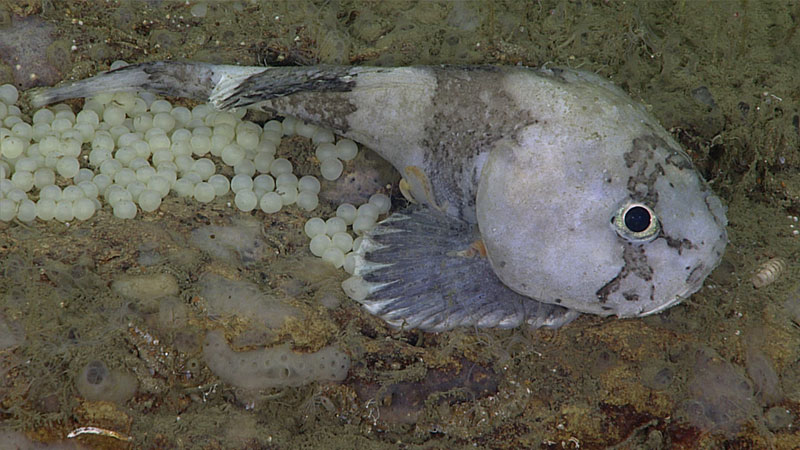
by Scott C. France, University of Louisiana at Lafayette
July 5, 2019
Video courtesy of the NOAA Office of Ocean Exploration and Research, Windows to the Deep 2019. Download larger version (mp4, 84.9 MB).
If you are a frequent viewer of NOAA Ship Okeanos Explorer’s live-streaming video, then you have heard us discuss how much of the deep sea remains unexplored, and how valuable each dive of the remotely operated vehicle Deep Discoverer is in providing us with additional data about our planet. Equally important and exciting as revealing previously unseen parts of our deep seafloor are observations of interactions and behaviors among deep-sea animals that we rarely (or never before) have seen. On Dive 13 of our current expedition, which explored a minor canyon off of Roanoke, North Carolina, we were fortunate enough to make such an observation.
During the course of the dive, as we climbed the canyon wall from a depth of 1,034 meters (3,392 feet), we saw many Chaceon crabs (either or both golden deep-sea crab Chaceon fenneri or Atlantic deepsea red crab Chaceon quinquedens) and several pallid sculpin (Cottunculus thomsonii), a fish in the family known as Fatheads (Psychrolutidae), which are commonly observed resting on the seafloor.
At 920 meters (3,018 feet) depth we came upon a Chaceon crab perched above a white patch on the seafloor. A closer look revealed the patch to be a cluster of hundreds of eggs, proposed by Dr. Peter Auster (University of Connecticut and Sea Research Foundation - Mystic Aquarium) to have been deposited on the rock by a pallid sculpin. Already this was a valuable observation, telling us something about how and where pallid sculpins deposit their eggs and whether they are defended or left unguarded.

A sculpin with eggs rests on the seafloor. Image courtesy of the NOAA Office of Ocean Exploration and Research, Windows to the Deep 2019. Download larger version (jpg, 1.2 MB).
The observation was made more valuable as we watched the crab plucking eggs from the pile with its major chelipeds (clawed legs) and eating them. Furthermore, we observed dozens of amphipods (distant crustacean relatives of the crab) clinging to and crawling over the crab’s mouthparts. Many amphipods are scavengers, and, like ants at a picnic, they were presumably taking advantage of the sloppy feeding of the crab.
Ultimately, the crab plucked a bundle of more than a dozen eggs bonded together and moved away from the patch when a larger Neolithodes king crab marched through the area (it did not appear to be interested in the eggs). As noted by crustacean expert Dr. Martha Nizinski, Chaceon crabs are opportunistic feeders, meaning they will eat what they encounter as available, including “a variety of benthic infauna and epifauna, including mollusks and polychaete worms.” With this observation we can now definitely add fish eggs to that menu!